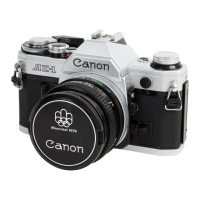Characteristics
The Canon AE-1 represents a landmark in
the history of SLR (Single-Lens-Reflex)
cameras.
Up to now, electronic control in SLR
cameras was limited, for example, to the
mechanism that decides exposure, but the
AE-1
is
the first camera in the world to
incorporate
a
CPU (Central Processing Unit)
by means of which automatic exposure,
memory transmission of signals, display,
regulation of time and completion signal are
all electronically controlled. It
is
an entirely
new kind of SLR camera.
A
high degree of automation has not been
restricted only to the camera.
It
extends to
the various accessories with the same standard
of precision.
The AE-1
is
the first camera to offer a
totally automated electronic photographic
system. It takes
its
name, AE-1, from this
concept.
Application
of
Electronics
is
the
Cornerstone
of
the Entire Design
Automation in the AE-1 was made
possible by the application of the
latest
electronic technology, after
a
thorough
analysis of all mechanisms and their
operation. The important mechanical features
made way for the electronic ones, thus
changing the very essence of the camera's
design.
As a result, a miniature computer
(CPU)
was successfully incorporated in the AE-1 for
the first time in the world to compute, judge,
control, display and regulate required in-
formation.
Adoption
of
the
Most
Advanced Ele-
ctronic Technology
The
I'L
(Integrated Injection Logic), as
far as
its
applications in photography are
concerned,
is
the most outstanding achieve-
ment in electronics up to date. An
LSI digital
circuit with extremely high properties of
accumulation, an operational amplifier, a
circuit with full use of an analog switch,
a
hyperbolic function resistance using both
thick and thin film technology, an
analog-
digital convertor, and the proper interfaces,
together with their construction and arrange-
ment in modular form, represent techno-
logical breakthroughs that go well beyond the

